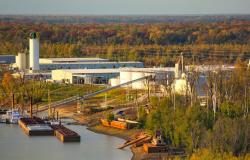Ending the Fossil Fuel Era Is the Only Way to Halt Global Warming and Stop Environmental Injustice

The decarbonization ideals underlying the Green New Deal provide the only realistic way to halt global warming and build a sustainable, resilient, and equitable future.
Environmental justice is a crucial component of the broader struggle for a sustainable, resilient, and equitable future. So is the end of the fossil fuel era; in fact, decarbonization and environmental justice go hand in hand.
The environmental justice movement traces its origins to the Civil Rights Movement of the 1960s. As such, it is deeply rooted in black history.
The Memphis Sanitation Strike in 1968, which drew Martin Luther King Jr., is regarded as the first nationally mobilized protest against environmental injustice.
In 1982, African Americans organized a mass protest against a polychlorinated biphenyl (PCB) landfill in Warren County, North Carolina, an event that served as the catalyst for the birth of a political movement dedicated to fighting environmental injustice and environment racism.
Of course, other communities of color had also mobilized against potential environmental threats, even before Warren County. In the 1960s, Cesar Chavez led a fight to organize migrant farmworkers. He founded the National Farm Workers Association in 1962 with the aim of overthrowing a farm labor system in the US that treated farm workers as slaves. Chavez had also recognized early on the dangers of exposing farm workers to pesticides in the fields, and in the early 1970s campaigned successfully to have DDT banned on account of its adverse environmental effects.
There can be no denying that minority and low-income communities have historically borne a disproportionate burden of environmental risks. Poor and racial-ethnic minority populations are far more likely to live near polluters and breathe polluted air. Robert Bullard’s studies showed that hazardous waste, garbage dumps and polluting industries almost always end up in poor and predominantly black communities rather than white, affluent suburbs.
Indeed, a 2017 report from the NAACP, the Clean Air Task Force, and the National Medical Association affirmed that African Americans are 75 percent more likely than other Americans to live near industrial plants that pollute water and air and erode the quality of life. In turn, a 2018 study by Environmental Protection Agency (EPA) scientists found that African Americans faced a 54 percent higher health burden compared to the general population. Non-white communities had a 28 percent higher health burden and those in poverty had a 35 percent higher burden.
Environmental racism is undoubtedly very real, and the federal government has known about it for many decades. Yet, “there is no federal law governing environmental injustice,” although environmental justice was institutionalized as a priority of the federal government in 1994 with the signing of Executive Order 12898 by Bill Clinton. Whatever progress has been made in the fight against environmental injustice and environmental racism has been due to community organizing and activism.
One of the earliest organizations dedicated to fighting environmental injustice is Communities for a Better Environment. It was founded in 1978 with a mission to empower people in California’s poor communities and communities of color to take action in order “to achieve environmental health and justice by preventing and reducing pollution and building green, healthy and sustainable communities and environments.”
A decade later, the fight against environmental injustice and environmental racism picked up considerable steam with the formation of multiple of organizations in the US. Included in this group are WE ACT for Environmental Justice (1988), the Center for Race, Poverty & the Environment (1989), the Indigenous Environmental Network (1990), the Southwest Network for Environmental and Economic Justice (1990), the Deep South Center for Environmental Justice (1992), and the National Black Environmental Justice Network (1999). Earth Rights International, the first organization founded on the belief that US corporations could be held accountable for environmental crimes and human rights abuses committed abroad, came into being in 1995 and has evolved into a global movement dedicated to the fight for climate justice.
More grassroots environmental justice organizations surfaced in the years ahead not only because of increasing public awareness of climate change but also because environmental injustice remained widespread in the US. There are currently more than 140 major cases monitored by Environmental Justice Atlas. And virtually all of them are in communities where economically disadvantaged and racial-ethnic minority populations reside.
Over the years, Louisiana’s “Cancer Alley” has come to be seen as one of the most blatant examples of “environmental racism.” "Cancer Alley" is an 85-mile long stretch of the Mississippi river overrun with petrochemical facilities. It is one of the most polluted places in the US, and the cancer risk for the predominantly African American residents in the communities closest to the plants is 50 times the national average.
Louisiana’s “Cancer Alley” is also a blatant example of government failure. But this shouldn’t come as a surprise given the political influence of the oil, gas, and chemical industries. Moreover, ProPublica’s investigation of cancer-causing pollution from industrial facilities also exposed flaws in the pollution prevention and enforcement policies of EPA.
On the positive side, environmental organizations have scored some impressive victories over the years, especially lately. Biden cancelled the Keystone X Pipeline after a 10-year campaign against it by organizations such as the Sierra Club. The PennEast Pipeline was also cancelled, and California has taken action to phase out fracking by 2024.
However, many activists stress the point that environmental justice cannot be disassociated from racial justice. This is an issue that has caused long-standing friction between traditional environmental groups and environmental justice organizations. Nonetheless, the evolution of the environmental justice movement has led to growing collaborations and networks and continuous advancement of the environmental justice agenda. In talking to various environmental activists, a consensus seems to be emerging on the need to strengthen efforts to limit global warming.
This is absolutely essential for combatting effectively environmental injustice and environmental racism. Decarbonization is the key to tackling global warming and environmental injustice. Fossil fuels lie at the heart of the climate crisis facing the world at large and of the health and environmental injustices facing poor and minority communities.
Fossil fuels are responsible for the climate crisis, generate air and water pollution, cause millions of deaths each year, carry a price tag for the world economy which runs into hundreds of billions of dollars annually, and perpetuate environmental injustice and environmental racism.
In this context, true leadership in the fight against global warming and environmental injustice necessitates being involved in the fight to end global fossil fuel use. The decarbonization ideals underlying the Green New Deal provide the only realistic way to halt global warming and build a sustainable, resilient, and equitable future.
C.J. Polychroniou is a GP columnist and a political economist/political scientist who has taught and worked in numerous universities and research centers in Europe and the United States. His latest books are The Precipice: Neoliberalism, the Pandemic and the Urgent Need for Social Change (A collection of interviews with Noam Chomsky; Haymarket Books, 2021), and Economics and the Left: Interviews with Progressive Economists (Verso, 2021).
This first appeared on Common Dreams.
Photo by Bearded Texan Travels from Pexels


